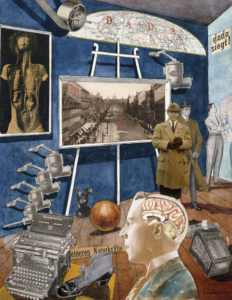Change Comes From the Margins

Detail from “Dada Conquers,” by Raoul Hausmann.Credit Raoul Hausmann/Bridgeman Images, via Artists Rights Society (ARS), New York, via ADAGP, Paris, 2015
By COSTICA BRADATAN
The New York Times, Opinionator, The Stone
In 1916, Hugo Ball, the German writer who would soon become a founding member of the Dadaist movement, wrote the following account of his first meeting with the men who would be his artistic and philosophical compatriots: “An Oriental-looking deputation of four little men arrived, with portfolios and pictures under their arms: repeatedly they bowed politely. They introduced themselves: Marcel Janco the painter, Tristan Tzara, Georges Janco, and a fourth gentleman whose name I did not quite catch.”
Ball was also the creator of the “Cabaret Voltaire” in Zurich, a city where the Romanian Tzara had come to shelter from the war. But almost as soon as he arrived, Tzara started a war of his own, an artistic revolution of grand proportions. Dadaism may well have started on the first evening at “Cabaret Voltaire” in February 1916, with Janco’s paintings and Tzara’s poetic performance. All these men, in one sense or another, began their transformative work from the margins.
Ball’s somewhat inelegant account suggests that Tzara and the others showed up carrying their marginality around quite visibly. Looking “Oriental” (at that point in time, a label that most certainly implied “otherness”), appearing slightly lost and bowing more than they should have — as recent immigrants often tend to. Tzara was indeed doubly marginal: as a Jew and as a Romanian. At the time Jews in Romania were so marginal that they could not even become citizens; and in Europe Romania suffered — as it still does — from that kind of marginal condition for which those living in better places use the condescending euphemism “exotic.”
And yet it must have been Tzara’s marginality that enabled him to do what he did: founding an artistic movement meant to deride systematically a civilization whose blind trust in instrumental rationality and fetishization of technology had pushed it into one of the most destructive wars the world had ever seen. For Dadaism the center — be it artistic, philosophical, intellectual, economic or political — was not worthy of anything but mockery. Tzara could afford the gesture; coming from the furthest margins, he didn’t have any qualms about crying out loud against and smashing the conventions of the center, exposing its damaging lies, and turning the dismantling of its pious proclamations into a prolific career.
Tzara’s case is not isolated. Indeed, there is a strong sense that not only Dada but also avant-garde in general is very much about a rebellion of the margins against the center. A remarkable number of avant-garde artists of the 19th and 20th centuries came — in person or vicariously, through their work — from the margins: Munch, Malevich, Brancusi, Picasso, Chagall, Kafka, Borges, Joyce, Frida Kahlo, Paul Celan and Fernando Pessoa, to name just a few.
Of course this process has never been restricted to art movements. And geography has no special claim on marginality; the center can have its own marginals — racial, ethnic, social, political, intellectual and epistemic, as we have forcefully been reminded of late. Historically, figures like Walter Benjamin, Hans Jonas and Simone Weil effected their own influence by operating from outside the standards of their accepted academic disciplines.
While it may seem like a mere staple of historical progress, the almost electric force of change from the margins is felt by us anew each time a damaging or oppressive convention is smashed or overturned. In the United States, we are immersed in such a moment, after an almost dizzying chain of events — the most immediate and profound being the Supreme Court ruling legalizing same-sex marriage; the increased cultural awareness and tolerance of gays, lesbian and transgender people, brought to the attention of many in the mainstream by the public transformation of Bruce Jenner into Caitlyn Jenner; and the gradual changes in policing being put into effect in cities across the United States. Despite the possible impression that each shibboleth was toppled overnight, each was the result of years of agitation, strategic fighting and pressure on the center from those outside it.
•
It would be a simplification of the full nature of the center to identify it as merely the site of social change or of victories in the march toward what we might like to believe is greater social justice. The center has a character of its own, which does not care one way or the other about our moral imperatives.
By definition, any center is a site of concentration and intensity — after all, it’s the place toward which everybody is attracted in some way or another. That’s also what makes it so formidable. The center possesses a wealth of prospects, opportunities and resources, but also anxieties — it is the place where the possibility of collapse, disintegration or descent into chaos figure prominently. To keep such dangers at bay, life at the center has to be regulated in every detail, its energy well managed, impulses properly channeled and spontaneity standardized. Sophisticated and expensive bureaucracies are developed to make sure that the pursuit of happiness does not turn into a stampede.
There is, then, a certain way of conducting your life at the center, of making a living, getting an education, writing an academic paper, of greeting your neighbor, dressing yourself or just sitting at the table. You signal your determination to belong to the center by unreserved conformation to its standards. For all these elaborate protocols are also meant to ensure that not everybody gets in and that enough are left out; this way the center makes itself perpetually desirable.
Power and standardization, though, make for an intriguing combination: to gain full access to the former you have to excel at dealing with the latter. The better one is at following the standards established by the center the more one advances towards the place of power. And that can be intoxicating. Among the many privileges of the center, for example, is the power to name things, one of the greatest powers of all. From there you can say what others are doing, and who they are, without them having any say in the process.
As long as one does not follow the standards set up by the mainstream (the center’s other name), one’s work is in vain, no matter how brilliant or original it is. Indeed, the more original, the more problematic. In 1925, one of the finest institutions of higher learning in Europe, Goethe University Frankfurt, rejected Walter Benjamin’s habilitation thesis, “The Origin of German Tragic Drama.” The work did not meet the standards of the German academia, which disqualified Benjamin from teaching at a German university. The center’s punishment for disobedience can be crushing.
What usually happens as a result is that an inordinate amount of talent, energy and time is spent on figuring out the best ways to elbow one’s way to the core of the mainstream. Then, once there, one has to behave in a way that will never jeopardize one’s position. Since most do what they can to keep their place within the status quo, far-reaching innovation is usually discouraged, and conformism rules. In the sphere of humanistic scholarship, for example, that’s conspicuous in the scholasticism that often comes to dominate one discipline or another. Desperate that they not be left out, the aspirants (Ph.D candidates!) blindly imitate the establishment’s preferred style — using and abusing the same formulaic language, the same safe patterns of thinking, the same old tricks.
“Creativity,” then, often boils down to recipes for the reproduction of the same with a minimum of variations; only a select few would risk their position by engaging in something too bold. Yet if this conformity remains unchallenged over time, a general sense of atrophy threatens to set in. That’s when the center, as a matter of life and death, needs significant challenges from the outside.
And that’s what marginals are for: to stick out their tongues at the center’s elaborate protocols, at everything “established” and “respectable.” They use the center’s standards — if they ever do — only to undermine them. Marginals, uninvolved in the ceremonies of the center, often end up not taking anything too seriously. In the arts, they often make the greatest ironists because, for them, irony is much more than a mode of expression, it is a way of life.
•
The biggest irony, however, is that all these attempts at derision and subversion, all the marginals’ mockery, usually end up making the center stronger; they are needed in the same vital way an organism needs antibodies. If the center manages to recruit the marginals to work for its own purposes, then it is saved. Indeed, the center often thrives on marginals. Take the academy: When the mainstream is just about to collapse under the weight of its own scholasticism, marginals can save it through a healthy dose of unorthodox ideas, wild theories and other shocking novelties. Not only did Benjamin eventually become part of the canon after his death, but he has revitalized significantly the same field in which his habilitation thesis was found substandard. The savage novelty of his thinking, the unusual cast of his mind and his profoundly unclassifiable genius — all markers of his marginality — have ended up not only strengthening the center but also expanding its epistemic horizons. That may also be the legacy of the American marginal, who have enacted their own form of change on the center.
But even in their moment of victory, those very same outsiders face a challenge. Marginals know only too well that, by subverting the center, they risk becoming part of it; those who challenge the canons or ideological foundations of the mainstream most vehemently can turn one day into canonic figures themselves — think Picasso, Martin Luther King Jr., Bob Dylan.
But perhaps there is something further to learn from the Dadaists. Since they led profoundly ironical lives they don’t mind: One more irony doesn’t really matter, the whole thing is a farce anyway. “Everybody knows that Dada is nothing,” says Tzara. “Like everything in life, Dada is useless.”
Among the center’s chief virtues may be that of knowing how to absorb the healthy dose of nihilism that marginals often smuggle in with them from the periphery.
Costica Bradatan is an associate professor in the Honors College at Texas Tech University and the religion/comparative studies editor for The Los Angeles Review of Books. His most recent book is “Dying for Ideas. The Dangerous Lives of the Philosophers.”
Follow The New York Times Opinion section on Facebook and on Twitter, and sign up for the Opinion Today newsletter.
http://opinionator.blogs.nytimes.com/2015/06/30/change-comes-from-the-margins/?_r=0
